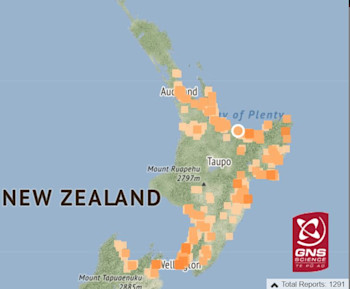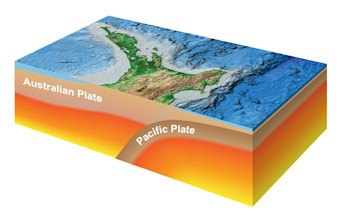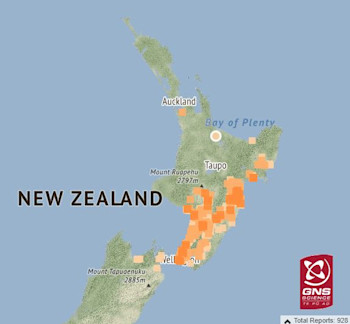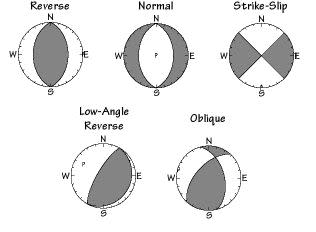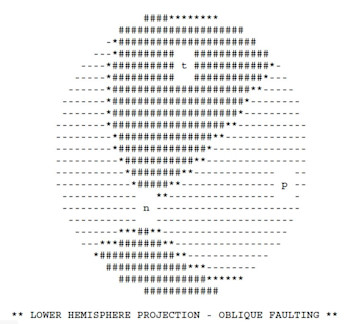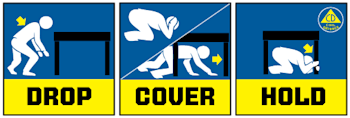
Deep earthquakes and beach balls – what’s happening under the North Island?
Last week (23 March) over 1200 people reported feeling an earthquake in the Bay of Plenty, although many of these reports were far from the quake itself. Today we explore the science of deep earthquakes in the North Island and why this phenomena happens.
Why is shaking different from deep quakes?
We often get felt reports for deep earthquakes that are some distance from the earthquake and very few around the actual epicentre. People often ask, ‘how does that happen’? The recent M5.3 on Tuesday 23rd March, is a good example to explore. The quake was 25km West of Whakatane. A large number of felt reports came from the east and south of the North island, with only a few in the central plateau. This distribution of felt reports is due to the earthquake's depth, location and ‘what’s under our feet’.
Under our feet:
The North Island sits on the Australian Plate. Typically, deep earthquakes occur in the Pacific Plate, which is subducting or diving under the North Island. The 'slab' of subducting rock in the upper portion of the Pacific Plate is rigid (the dark brown area in the graphic below) while the surrounding rock (shown in yellow) is much softer - a mixture of rigid and molten rock. Around the central plateau where we see some of our volcanoes, like Ruapehu, as you may expect there is more molten rock.
The rigid rock of the subducting Pacific Plate is better at transmitting earthquake waves than the softer, semi-molten rock. In fact, molten rock ‘dampens’ the energy from deeper earthquake and helps to explain why the shaking is felt less near the epicentre when earthquakes occur in that area.
When an earthquake happens in or near this slab of subducting plate, most of the quake’s energy travels up and along the slab to the surface - closer to the East and South of the North Island – resulting in the shaking from the earthquake being felt more widely across those areas.
Another great illustration of this phenomena is from a deeper M5.0 earthquake in Bay of Plenty, October 2019. As you can see below, there were no felt reports surrounding the earthquake, unlike the event on Tuesday 23rd.
They were both deep earthquakes, and in similar areas – so why the difference? Here’s a little about the science of earthquake types …
Beach-Balls and earthquake types:
We always know an earthquake’s size, depth and location – but there is a lot more going on behind the scenes. The mechanism, or type of the earthquake, changes how energy radiates from the earthquake source. This can change how it is felt as well.
Our scientist John Ristau produces focal mechanisms for the larger earthquakes we experience in and around New Zealand. Focal mechanisms are shown as a graphic symbol – they are a way of showing the fault and direction of slip from an earthquake, using circle and curves. They’re often nicknamed ‘beach balls’!
Below is the focal mechanism for the M5.3 Bay of Plenty earthquake on Tuesday, this shows the earthquake has oblique faulting.
Although some earthquakes may look similar, like the two earthquakes discussed above, the focal mechanisms can give them quite different shaking on the surface. This is why the event last week was felt more across Auckland and Bay of Plenty than the earthquake in 2019.
If you would like to read more about the different fault types, you can read about them here.
Remember in an earthquake to Drop, Cover and Hold
And if you feel a Long or Strong earthquake, or receive an emergency mobile alert for a tsunami, Get Gone to higher ground immediately, or as far inland as possible.
NEMA (National Emergency Management Agency) have a great website with information on what to do before, during and after an earthquake. EQC (The Earthquake Commission) also have helpful information on how to get your home, apartment, or rental prepared for a natural disaster.
Attributable to: Elizabeth Abbott, John Ristau GNS Geohazards Duty Seismologists
Media enquiries: media@gns.cri.nz or 021 574 541
